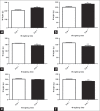Quercetin Prevents Body Weight Loss Due to the Using of Superparamagnetic Iron Oxide Nanoparticles in Rat
- PMID: 29456979
- PMCID: PMC5812102
- DOI: 10.4103/abr.abr_141_17
Quercetin Prevents Body Weight Loss Due to the Using of Superparamagnetic Iron Oxide Nanoparticles in Rat
Abstract
Background: Superparamagnetic iron oxide nanoparticles (SPION) have been largely considered for numerous applications in biomedicine such as magnetic resonance imaging, hyperthermia, cell tracking, anticancer treatment, and targeted delivery of drugs or genes. However, they may have side effects such body weight loss. Quercetin (QT), a strong antioxidant and free radical scavenger and a natural flavonoid, has a wide range of biological and therapeutic effects. In this study, the effect of QT on prevention of weight loss due to the using of SPION has been investigated.
Materials and methods: SPION and QT-SPION were administered orally at 50 and 100 mg/kg for 7 days. Then, the body weight was measured at the beginning and the end of the study.
Results: Rats fed with 50 and 100 mg/kg SPION showed a significant weight loss, whereas those that fed with 50 mg/kg QT-SPION did not. A weight loss was observed in rats treated with 100 mg/kg of QT-SPION.
Conclusions: The results of this study showed that quercetin could prevent weight loss due to the SPION.
Keywords: Nanoparticles; quercetin; superparamagnetic iron oxide; weight loss.
Conflict of interest statement
There are no conflicts of interest.
Figures

Similar articles
-
Using superparamagnetic iron oxide nanoparticles to enhance bioavailability of quercetin in the intact rat brain.BMC Pharmacol Toxicol. 2018 Sep 25;19(1):59. doi: 10.1186/s40360-018-0249-7. BMC Pharmacol Toxicol. 2018. PMID: 30253803 Free PMC article.
-
Quercetin-Conjugated Superparamagnetic Iron Oxide Nanoparticles Protect AlCl3-Induced Neurotoxicity in a Rat Model of Alzheimer's Disease via Antioxidant Genes, APP Gene, and miRNA-101.Front Neurosci. 2021 Feb 25;14:598617. doi: 10.3389/fnins.2020.598617. eCollection 2020. Front Neurosci. 2021. PMID: 33716639 Free PMC article.
-
Quercetin conjugated with superparamagnetic iron oxide nanoparticles improves learning and memory better than free quercetin via interacting with proteins involved in LTP.Sci Rep. 2019 May 3;9(1):6876. doi: 10.1038/s41598-019-43345-w. Sci Rep. 2019. PMID: 31053743 Free PMC article.
-
Superparamagnetic Iron Oxide Nanoparticles (SPION): From Fundamentals to State-of-the-Art Innovative Applications for Cancer Therapy.Pharmaceutics. 2023 Jan 10;15(1):236. doi: 10.3390/pharmaceutics15010236. Pharmaceutics. 2023. PMID: 36678868 Free PMC article. Review.
-
Potential for Treatment of Glioblastoma: New Aspects of Superparamagnetic Iron Oxide Nanoparticles.Anticancer Res. 2020 Nov;40(11):5989-5994. doi: 10.21873/anticanres.14619. Anticancer Res. 2020. PMID: 33109536 Review.
Cited by
-
Combined surface functionalization of MSC membrane and PDA inhibits neurotoxicity induced by Fe3O4 in mice based on apoptosis and autophagy through the ASK1/JNK signaling pathway.Aging (Albany NY). 2023 Jul 19;15(14):6933-6949. doi: 10.18632/aging.204884. Epub 2023 Jul 19. Aging (Albany NY). 2023. PMID: 37470690 Free PMC article.
-
Synergistic Effect of Quercetin Magnetite Nanoparticles and Targeted Radiotherapy in Treatment of Breast Cancer.Breast Cancer (Auckl). 2022 Mar 25;16:11782234221086728. doi: 10.1177/11782234221086728. eCollection 2022. Breast Cancer (Auckl). 2022. PMID: 35359610 Free PMC article.
-
Dry-feed Added Quercetin Mitigates Cyclophosphamide-induced Oxidative Stress, Inflammation and Gonadal Fibrosis in Adult Male Rats.Antiinflamm Antiallergy Agents Med Chem. 2025;24(1):43-56. doi: 10.2174/0118715230316410240821105658. Antiinflamm Antiallergy Agents Med Chem. 2025. PMID: 39350549
-
Quercetin Abates Aluminum Trioxide Nanoparticles and Lead Acetate Induced Altered Sperm Quality, Testicular Oxidative Damage, and Sexual Hormones Disruption in Male Rats.Antioxidants (Basel). 2022 Oct 28;11(11):2133. doi: 10.3390/antiox11112133. Antioxidants (Basel). 2022. PMID: 36358505 Free PMC article.
-
Exploring the Therapeutic Potential of Phytochemicals in Alzheimer's Disease: Focus on Polyphenols and Monoterpenes.Front Pharmacol. 2022 May 4;13:876614. doi: 10.3389/fphar.2022.876614. eCollection 2022. Front Pharmacol. 2022. PMID: 35600880 Free PMC article. Review.
References
-
- Kumari A, Yadav SK, Pakade YB, Singh B, Yadav SC. Development of biodegradable nanoparticles for delivery of quercetin. Colloids Surf B Biointerfaces. 2010;80:184–92. - PubMed
-
- Wu TH, Yen FL, Lin LT, Tsai TR, Lin CC, Cham TM, et al. Preparation, physicochemical characterization, and antioxidant effects of quercetin nanoparticles. Int J Pharm. 2008;346:160–8. - PubMed
-
- Manach C, Scalbert A, Morand C, Rémésy C, Jiménez L. Polyphenols: Food sources and bioavailability. Am J Clin Nutr. 2004;79:727–47. - PubMed
-
- Chakraborty S, Stalin S, Das N, Choudhury ST, Ghosh S, Swarnakar S, et al. The use of nano-quercetin to arrest mitochondrial damage and MMP-9 upregulation during prevention of gastric inflammation induced by ethanol in rat. Biomaterials. 2012;33:2991–3001. - PubMed
LinkOut - more resources
Full Text Sources
Other Literature Sources

